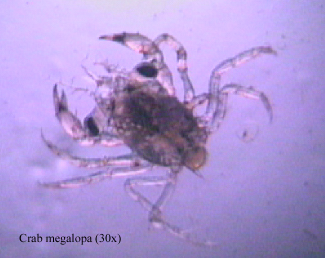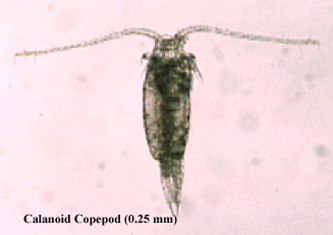
The phylum Arthropoda encompasses a tremendous range of marine species and body plans, as well as an amazing diversity of terrestrial insects and spiders. Coastal and nearshore marine habitats, including the plankton, feature a number of these forms, such as copepods, crabs, and barnacles. While the mobile, highly jointed bodies of crabs and copepods may seem quite different from the sessile, immobile carapaces of barnacles, these groups share important traits: a chitinous exoskeleton and a need to molt that exoskeleton in order to grow larger.Invertebrates in the Plankton: Arthropoda
In our observations of the plankton, we found both larval and fully planktonic species to be very abundant: during our night-lighting from the Lab dock, we caught many hundreds of two crab larval stages, zoea and megalopae. And in our daytime plankton tow in the Straits area close to Friday Harbor, we caught great numbers of several different types of copepods. Photos of these and our other discoveries follow.
 |
This crab megalopa (4 mm in length) was one of hundreds captured by night-lighting during the last week of June. It swam strongly at the water's surface, its legs occasionally splaying energetically. This megalopa is the final larval stage of true crabs, preceding the benthic juvenile stage and following several zoeal stages. One of the most recognizable brachyurans (also known as true crabs) along the Pacific coast is the Dungeness crab (Cancer magister), a species with considerable commercial and cultural value in the region. |
Anomuran Crabs
| This zoea of a porcelain crab (Petrolisthes eriomerus, 3 mm in length) is well defended from potential predators; notice its long, inflexible rostral spine. The porcelain crab belongs to the group known as anomuran crabs, which include hermit, porcellanid, lithodid, and galatheid crabs. The zoea uses its first two pairs of thoracic appendages, the maxillipeds, to swim, making it one of the more agile planktonic animals. The zoea will develop into a megalopa form, sometimes referred as a glaucothoe, and then into a functional adult. |  |
 |
Copepods are the most abundant multicellular animals in the world, living in both freshwater and marine environments. The most abundant free-living marine copepod is the calanoid (seen on the right); it is recognizable by the long first antennae, which it flicks in swimming locomotion. This type of copepod uses mouth parts called maxillae to scoop phytoplankton, small invertebrates (including other copepods), or fish larvae from the water. Copepods are also the primary consumers of phytoplankton and are an important food source to fish, baleen whales, and other invertebrates. |
 |
In all copepods, fertilization occurs when the egg passes out the female genital tract. Many copepods carry the eggs in sacs on the body; calanoids carry one egg sac as seen above. Development of the eggs depends strongly on sea temperature (see development of eggs at different temperatures), species, and egg size. The reproductive season depends on the species and its location. |
|
This larval stage, called a nauplius, is found in barnacles, copepods, penaeid shrimps, and ostracods. It swims by using its jointed appendages that are moved by muscle contraction. These larvae have a nauplier eye, made up of photoreceptor cells that are thought to give rise to the photoreceptors in some adult forms. They frequently molt (shed their hard outer skeleton) to enable growth during this phase. Barnacles are hermaphrodites. They release their larvae into the water column at the nauplius stage. After several moltings, the final larval stage before settling is called a cyprid. The cyprid stage is non-feeding. For more information on adult barnacles see the Cattle Point page. |
 |
Cladocerans
 |
An example from a group of crustaceans called cladocerans is seen here. These adult animals swim using the second antennae and they feed by either filtering microscopic algae or preying on small animals. Most cladoceran females reproduce by parthenogenesis, which produces males and females without sexual recombination. However, they also have sexual reproduction that produces females. This marine representative, Evadne. uses the carapace as a brood chamber (a place to store eggs). A more commonly known freshwater species is Daphnia. |